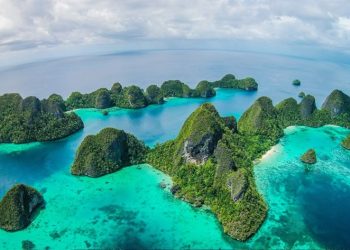Jakarta, Indonesia Sentinel — Indonesia, renowned for its rich biodiversity, is home to numerous endemic species, including the endangered Borneo banteng (Bos javanicus lowi). This rare subspecies of wild cattle is under threat of extinction, but recent sightings captured by camera traps have bring conservationists joy and hope. The footage was recorded in Kayan Mentarang National Park (TNKM), North Kalimantan.
“Two Borneo banteng were recorded on camera traps near the Beraha River, Long Berini Village, within the SPTN Region II of Long Alango,” stated the park in a post on its official Instagram account on Sunday, October 20, 2024. “This area is a known roaming ground for the Borneo banteng, and the cameras were strategically placed to monitor the population.”

According to Indonesia’s Directorate General of Natural Resources and Ecosystem Conservation (KSDAE), the banteng is a native species of Southeast Asia. It is one of the world’s most endangered large mammals, classified as wild cattle.
The International Union for Conservation of Nature (IUCN) Red List has designated the banteng as “Endangered,” highlighting its risk of extinction.
In Indonesia, the species is protected under Regulation P.92/MENLHK/SETJEN/KUM.1/8/2018, which outlines legal protection for endangered plants and animals. The banteng faces numerous threats, from habitat loss to hunting.
Borneo Banteng Subspecies
Indonesia is home to two subspecies of banteng: the Javan banteng (Bos javanicus javanicus), found in Java, and the Borneo banteng (Bos javanicus lowi), which inhabits parts of Borneo. Specifically, the Borneo banteng can be found in Kutai National Park, Kayan Mentarang National Park, and the Blantikan area in Central Kalimantan’s Lamandau Regency.
Though morphologically, Borneo banteng is similar to Javan Banteng. Both has features, including white markings on its rump and lower legs, giving the appearance of wearing white socks. However, the differences of borneo banteng is its absence of white or pale brown spots above the eyes and a white band around its muzzle, as well as its relatively smaller stature.
The Borneo banteng is smaller than other banteng subspecies, with body lengths ranging from 190 to 225 cm and shoulder heights up to 160 cm. Adult males can weigh between 600 to 800 kg, while females typically weigh around 400 kg.
Unfortunately, the Borneo banteng’s distribution is extremely limited, and its population is in continual decline. In Kayan Mentarang National Park, banteng populations are mainly found in the Long Tua grazing area within SPTN II Long Alango, where they are a focal point of conservation efforts.
Threats to the Banteng Population
Hunting remains one of the threats to the banteng population. Many local communities remain unaware of the banteng’s protected status and its critically endangered condition. Habitat loss, driven by logging, mining, and land conversion, further exacerbates the problem. These activities disrupt the banteng’s natural habitat, affecting food and water sources, breeding grounds, and shelter, not only for banteng but also for other wildlife.
To combat these threats, the Indonesian government has implemented several conservation measures, including public awareness campaigns about the dangers of hunting and the prohibition of land and forest burning. The hunting of the Borneo banteng is prohibited under Indonesia’s Conservation Law (UU No. 5/1990), which makes it illegal to hunt, kill, preserve, or trade protected wildlife, whether alive or dead.
Conservation efforts extend beyond government initiatives. Communities and private companies have also played a role in protecting the banteng by refraining from hunting, trading, or damaging the banteng’s habitat.
As Indonesia strives to protect its rich biodiversity, the recent sightings of the Borneo banteng in Kayan Mentarang National Park offer a critical reminder of the need for continued conservation efforts to ensure the survival of this endangered species.
(Raidi/Agung)

























